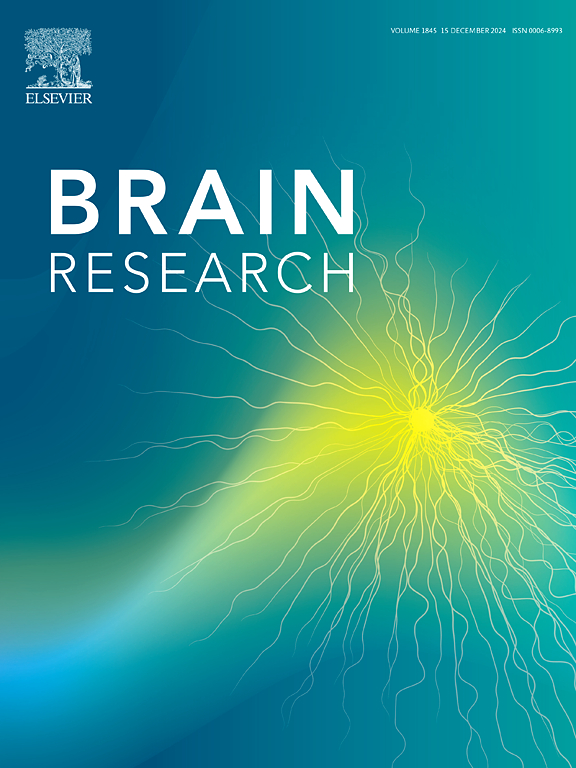AMPK介导针刺对脑缺血再灌注大鼠的抗铁下垂作用
IF 2.7
4区 医学
Q3 NEUROSCIENCES
引用次数: 0
摘要
背景:针刺治疗缺血性脑卒中在临床上是有效的。该报告表明,能量应激部分通过AMPK抑制铁下垂。然而,激活AMPK的作用是否与缺血性脑卒中中的铁下垂有关,针刺是否通过激活AMPK抑制铁下垂的途径达到对缺血性脑损伤的神经保护作用,尚未得到证实。方法将所有大鼠随机分为4组:假手术组、MCAO/R组、MA (MCAO/R +针刺)组、MAM (MCAO/R +针刺+二甲双胍)组。采用丝栓法造模大脑中动脉闭塞/再灌注损伤(MCAO/R)模型,MA组和MAM组均给予针刺电疗(1 MA, 2/15 Hz,各20 min)治疗,MAM组造模成功后继续给予二甲双胍(口服200 mg/kg)。测定大鼠神经功能缺损评分和梗死体积,观察普鲁士蓝染色和线粒体结构变化,测定脑组织Fe2+和MDA水平。对Western blot结果进行分析,检测TFR1、SLC7A11、GPX4和AMPK、p-AMPK蛋白的表达差异,从行为学、组织学和分子水平探讨脑缺血可能参与的病理过程以及针刺可能的保护机制。结果针刺可减轻缺血再灌注引起的脑损伤和线粒体损伤。进一步研究表明,针刺可降低MCAO/R大鼠病变海马区Fe2+、MDA水平及TFR1蛋白表达,增加SLC7A11、GPX4蛋白表达。此外,二甲双胍作为AMPK激活剂,显著增强了针刺对脑缺血损伤的保护作用,增强了针刺介导的MCAO/R大鼠损伤海马区Fe2+、MDA水平和TFR1蛋白表达的降低以及SLC7A11和GPX4蛋白表达的升高。结论针刺可抑制铁下垂,对缺血性脑损伤具有保护作用,其机制可能是通过激活AMPK来实现的。这拓展了针刺治疗缺血性脑卒中的作用机制。本文章由计算机程序翻译,如有差异,请以英文原文为准。

AMPK mediates the anti-ferroptosis effect of acupuncture in cerebral ischemia–reperfusion rats
Background
Acupuncture is clinically effective in the treatment of ischemic stroke. The report suggests that energy stress inhibits ferroptosis in part through AMPK. However, whether the effect of activating AMPK is related to ferroptosis in ischemic stroke and whether acupuncture can achieve neuroprotection against ischemic brain injury through the pathway of inhibiting ferroptosis by activating AMPK has not been confirmed.
Methods
In this experiment, all rats were randomly divided into 4 groups: Sham group, MCAO/R group, MA (MCAO/R + acupuncture) group, and MAM (MCAO/R + acupuncture + metformin) group. The middle cerebral artery occlusion/reperfusion injury (MCAO/R) model was created by the wire embolism method, and the MA and MAM groups received acupuncture treatment with electrotherapy (1 mA, 2/15 Hz, 20 min each), while the MAM group continued to receive metformin (oral gavage 200 mg/kg) after successful modelling. Neurological deficit score and infarct volume were measured, Prussian blue staining and mitochondrial structural changes were observed, and Fe2+ and MDA levels were determined in the brain tissue of the rats. Western blot results were analyzed to determine differences in the expression of TFR1, SLC7A11, GPX4 and AMPK、p-AMPK proteins in order to explore the possible pathological processes involved in cerebral ischemia at behavioral, histological and molecular levels and the possible protective mechanisms of acupuncture.
Results
Acupuncture attenuated ischemia–reperfusion-induced brain damage and mitochondrial damage. Further studies showed that acupuncture reduced the levels of Fe2+, MDA and the expression of TFR1 protein and increased the expression of SLC7A11 and GPX4 protein in the diseased hippocampal region of MCAO/R rats. In addition, metformin, as an AMPK activator, significantly enhanced the protective effect of acupuncture on cerebral ischemic injury and enhanced the acupuncture-mediated reduction of Fe2+, MDA levels and TFR1 protein expression and the increase of SLC7A11 and GPX4 protein expression in the lesioned hippocampal region of MCAO/R rats.
Conclusions
These findings suggest that acupuncture can inhibit ferroptosis and thus exert a protective effect against ischemic brain injury, and that this mechanism may be achieved by activating AMPK. This extends the mechanism of action of acupuncture in the treatment of ischemic stroke.
求助全文
通过发布文献求助,成功后即可免费获取论文全文。
去求助
来源期刊

Brain Research
医学-神经科学
CiteScore
5.90
自引率
3.40%
发文量
268
审稿时长
47 days
期刊介绍:
An international multidisciplinary journal devoted to fundamental research in the brain sciences.
Brain Research publishes papers reporting interdisciplinary investigations of nervous system structure and function that are of general interest to the international community of neuroscientists. As is evident from the journals name, its scope is broad, ranging from cellular and molecular studies through systems neuroscience, cognition and disease. Invited reviews are also published; suggestions for and inquiries about potential reviews are welcomed.
With the appearance of the final issue of the 2011 subscription, Vol. 67/1-2 (24 June 2011), Brain Research Reviews has ceased publication as a distinct journal separate from Brain Research. Review articles accepted for Brain Research are now published in that journal.
 求助内容:
求助内容: 应助结果提醒方式:
应助结果提醒方式:


